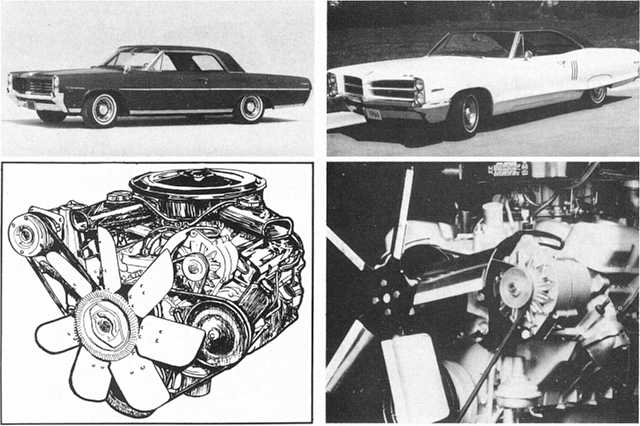
Clockwise, starting from top-left: the '64 Catalina 2-plus-2 sports coupe started the bucket seat front-and-rear phenomenon and featured such goodies are super wheels, wood-rimmed steering wheel. The 1966 2+2 represented a separate series, available in either hardtop-coupe or convertible models. The standard '66 2+2 engine was the 421-inch four barrel (with 3-speed synchro). Here's a '69 Grand Prix engine on the Pontiac dyno. Note special fan. The 1970 Firebird featured as standard the Formula 400 engine drawn here. The 400 had 400 Inches ('natch), and generated 330 horses with a 10.25-to-one compression ratio.
 |
The 389 had split flow exhaust headers made of cast iron. The 421s came through with the same headers cast in aluminum to save weight. If you drove too long with these aluminum headers, you burned holes in them. They were meant only for short dragstrip blasts, preferably of less than 13 seconds duration. You may be wondering why all the fuss about some exhaust manifolds which were just going to be ripped off for a set of headers, anyway. (This was before steel tube headers were being used extensively.) All the factories were working hard on efficient exhaust scavenging.
Cylinder heads were the same for both the Super Duty 389 and 421, actually holdovers from the '61 engine. They used 1.92-inch intake valves and 1.66-inch exhaust valves and had large ports. These were a lot better than the standard heads but not as good as the '62 1/2 heads with still larger ports and 2.02- and 1.76-inch valves. The new heads also used 1.65-to-one rockers which really boosted breathing capacity.
The Super Duty 421 with the 11-to-one compression, number ten McKellar and dual quads rated 405 horsepower at 5600 rpm. In one early road test of the engine in a Catalina 2-door hardtop, Roger Huntington took some accelerometer readings to determine the actual output of the engine at the clutch—465 horsepower and 510 lbs.-ft. of torque and this was with the early heads! This is fantastic output even by today's standards.
Since late 1960, Pontiac had been offering some lightweight aluminum body parts for over the counter sale. In '62 they made the lightweight body parts part of the 421 Super Duty package on the Catalina. The lightweight parts included the hood, both front fenders, front and rear bumpers, brackets, fender shields and other bits and pieces. Late in '62, Pontiac also released an aluminum case 4-speed with special aircraft quality steel gears that made the box almost bulletproof. They also released a small hood scoop for the aluminum hood.
With the Super Duty 389, a 3.42 rear axle ratio was standard. With the 421, you got a 4.30. If you didn't like these ratios, Pontiac's option book listed anything from a 2.56 to a 6.14.
About halfway through the model year, the Super Duty 389 was phased out and replaced by a single 4-barrel version of the 421. The 4-barrel 421 was rated 385 horsepower and nothing could touch it on the NASCAR superspeedways. Fireball Roberts and other Pontiac drivers cleaned house easily that year.
The '62 Super Duty 421 Catalina was undoubtedly the high point of Pontiac's performance history. On NASCAR tracks, the single 4-barrel version ran all over the opposition. On dragstrips, the Royal Pontiac 421 was turning 12.38s at over 116 mph with the big 3700 pound Cats. The '62 was also the most popular from a sales standpoint. Almost 1500 Super Duty packages were built in 1962.
On the street scene, the new Grand Prix was the style-setter for '62. Buckets and console were standard. Engine options again ranged up to the 348 horsepower tripower engine. Many buyers specified the 4-speed transmission.
In 1963, Pontiac made further improvements on the Super Duty package. The car had gotten bigger and heavier and just wasn't competitive even with the aluminum front end. Pontiac engineers put the Catalina on a crash diet and came up with the famous "Swiss cheese" Catalinas. Not only was the complete front end and rear bumper aluminum, but the entire chassis had huge holes drilled all along its length to further cut down weight. Plexiglass windows were a dealer installed option.
NEXT >
|